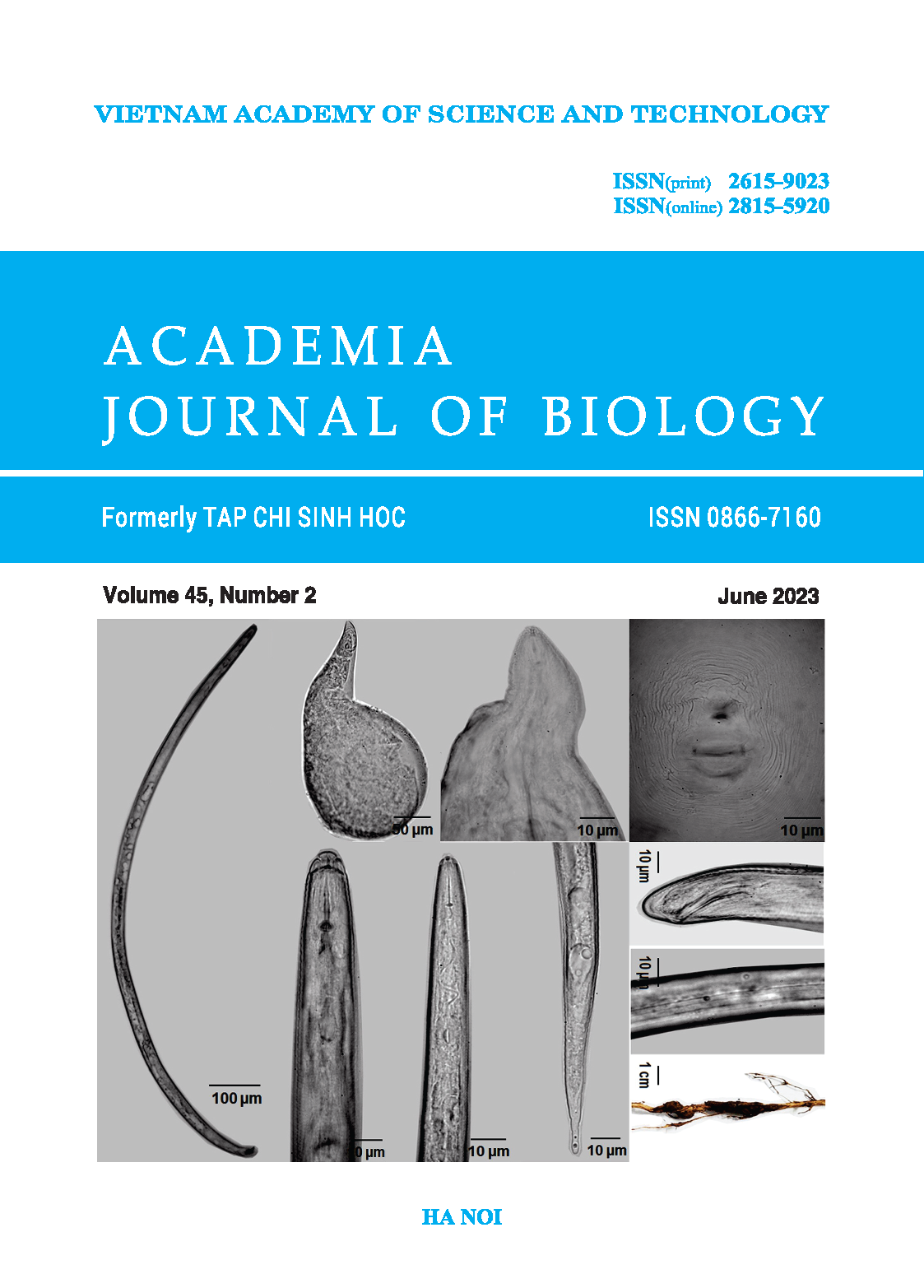Characterization of chalcone isomerase 4A \(\textit{(CHI4A)}\) gene in \(\textit{Pueraria mirifica}\)
Author affiliations
DOI:
https://doi.org/10.15625/2615-9023/18193Keywords:
Chalcone isomerase, flavonoid, isolation, polymorphisms, Pueraria mirificaAbstract
Pueraria mirifica is a popular medicinal plant and is rich in phytoestrogens, especially isoflavonoids. The chalcone isomerase (CHI) gene is well-known as a key factor in biosynthetic pathways such as flavonoid, isoflavonoid, and anthocyanin biosynthesis. Among four CHI subfamilies, group IV remained largely uncharacterized in P. mirifica. By isolation and gene cloning, the CHI4A gene was amplified and sequenced. A dataset that included CHI4A genes from isolation, transcriptome, and Glycine max CHI4A was constructed for analysis. A total of 31 single nucleotide polymorphism (SNPs) was detected among sequences and 14 SNPs were found in P. mirifica subgroups. Thirteen SNPs changed the amino acid sequences of CHI4A genes; however, they do not affect core active residues in the protein structure. Two active sites typical for group 4 CHI in the Fabaceae family: Ile50 and Tyr106; and one conserved site Asn113, were found in this study, which is similar to the result of the previous study on CHI4. A three-dimensional protein model of isolated P. mirifica CHI4A enzyme was constructed with a high confidence level. The result provides more information about the variation and protein profile of the CHI4A gene for further experiments.
Downloads
References
Dastmalchi M. & Dhaubhadel S., 2015. Soybean chalcone isomerase: evolution of the fold, and the differential expression and localization of the gene family. Planta, 241(2): 507–523. https://doi.org/ 10.1007/s00425-014-2200-5
Jez J. M., Bowman M. E., Dixon R. A. & Noel J. P., 2000. Structure and mechanism of the evolutionarily unique plant enzyme chalcone isomerase. Nature Structural Biology, 7(9): 786–791. https://doi.org/ 10.1038/79025
Jez J. M., Bowman M. E. & Noel J. P., 2002. Role of Hydrogen Bonds in the Reaction Mechanism of Chalcone Isomerase. Biochemistry, 41(16): 5168–5176. https://doi.org/10.1021/bi0255266
Jiang N., Doseff A. & Grotewold E., 2016. Flavones: From Biosynthesis to Health Benefits. Plants, 5(2): 27. https://doi.org/ 10.3390/plants5020027
Karabin M., Hudcova T., Jelinek L., & Dostalek P., 2015. Biotransformations and biological activities of hop flavonoids. Biotechnology Advances, 33(6): 1063–1090. https://doi.org/ 10.1016/j.biotechadv.2015.02.009
Lin L. M., Guo H. Y., Song X., Zhang D. D., Long Y. H. & Xing Z. B., 2021. Adaptive Evolution of Chalcone Isomerase Superfamily in Fagaceae. Biochemical Genetics, 59(2): 491–505. https://doi.org/ 10.1007/s10528-020-10012-z
Malaivijitnond S., 2012. Medical applications of phytoestrogens from the Thai herb Pueraria mirifica. Frontiers of Medicine, 6(1): 8–21. https://doi.org/10.1007/ s11684-012-0184-8
Ngaki M. N., Louie G. V., Philippe R. N., Manning G., Pojer F., Bowman M. E., Li L., Larsen E., Wurtele E. S. & Noel J. P., 2012. Evolution of the chalcone-isomerase fold from fatty-acid binding to stereospecific catalysis. Nature, 485(7399): 530–533. https://doi.org/ 10.1038/nature11009
Ralston L., Subramanian S., Matsuno M. & Yu O., 2005. Partial Reconstruction of Flavonoid and Isoflavonoid Biosynthesis in Yeast Using Soybean Type I and Type II Chalcone Isomerases. Plant Physiology, 137(4): 1375–1388. https://doi.org/ 10.1104/pp.104.054502
Wang S., Zhang S., Wang S., Gao P. & Dai L., 2020. A comprehensive review on Pueraria: Insights on its chemistry and medicinal value. Biomedicine & Pharmacotherapy, 131: 110734. https://doi.org/10.1016/j.biopha.2020.110734
Yin Y., Zhang X., Gao Z., Hu T. & Liu Y., 2019. The Research Progress of Chalcone Isomerase (CHI) in Plants. Molecular Biotechnology, 61(1): 32–52. https://doi.org/10.1007/s12033-018-0130-3
Downloads
Published
How to Cite
Issue
Section
License
Academia Journal of Biology (AJB) is an open-access and peer-reviewed journal. The articles published in the AJB are licensed under a Creative Commons Attribution-NonCommercial-NoDerivatives 4.0 International License (CC BY-NC-ND 4.0), which permits for immediate free access to the articles to read, download, copy, non-commercial use, distribution and reproduction in any medium, provided the work is properly cited (with a link to the formal publication through the relevant DOI), and without subscription charges or registration barriers. The full details of the CC BY-NC-ND 4.0 License are available at https://creativecommons.org/licenses/by-nc-nd/4.0/.












